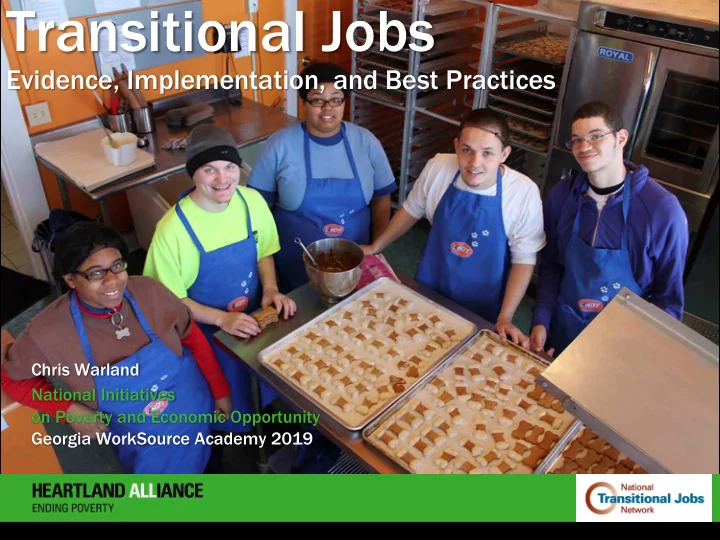

Transitional Jobs Evidence, Implementation, and Best Practices Chris Warland National Initiatives on Poverty and Economic Opportunity Georgia WorkSource Academy 2019
National Initiatives on Poverty & Economic Opportunity Dedicated to ending chronic unemployment and poverty.
National Initiatives on Poverty & Economic Opportunity Address syst systemic mic Advance issue issues s that drive chronic Dedicated to ending the he f fie ield ld unemployme chronic unemployment nt and poverty. Promote and nurture re rese sear arch h and e and evaluat aluation ion
Icebreaker! What was your first job? What did you learn? Momentum in policy, practice, funding, and research –but we need to make sure those youth who need help the most are not left behind 4
Transitional Jobs Overview 5
Defining TJ ■ Time-limited, wage- paid work ■ Supportive services ■ Skill development ■ Job development and retention services 6
The goals of TJ ■ Stabilize with income ■ Learn experientially ■ Address barriers ■ Build work history ■ Access incentives ■ Develop skills ■ Transition to permanent employment 7
The community benefits of TJ ■ Economic stimulus ■ Increased tax payments ■ Benefits to employers ■ Reduced recidivism ■ Reduced reliance on public benefits ■ Positive ROI 8
The History of TJ ■ Publicly subsidized employment has been around at last since the New Deal ■ TJ model was developed as a response to welfare reform ■ Has been expanded and tested with many populations ■ Many state and city governments now directly fund TJ
What does WIOA say about TJ? TRANSITIONAL JOBS.—The local board may use not more than 10 percent of the funds allocated to the local area…to provide transitional jobs…that— ■ are time-limited work experiences that are subsidized and are in the public, private, or nonprofit sectors for individuals with barriers to employment who are chronically unemployed or have an inconsistent work history; ■ are combined with comprehensive employment and supportive services; and ■ are designed to assist the individuals…to establish a work history, demonstrate success in the workplace, and develop the skills that lead to entry into and retention in unsubsidized employment. 10
Research Evidence
Evidence for the effectiveness of TJ ■ Has been very rigorously studied (multiple randomized control trials) ■ Very high work participation rates ■ Significant impacts on recidivism ■ Positive ROI ■ Works best for higher-risk individuals and those facing more barriers to employment
Center for Employment Opportunities ■ Rigorous random-assignment study by MDRC ■ Significant and long-lasting recidivism impacts (>3 years) ■ Positive ROI ■ Impacts were stronger with higher- risk participants
Enhanced Transitional Jobs Demonstration (ETJD) ■ Funded by US Department of Labor ■ Random assignment, 7 sites ■ Focus on returning citizens and noncustodial parents ■ Significant impacts on child support payments and recidivism ■ Evidence supporting integration of Cognitive-Behavioral Therapy
Subsidized Transitional Employment Demonstration (STED) ■ Funded by US Department of Health & Human Services ■ Random assignment, 7 sites ■ Focus on TANF recipients ■ Implementation report for one site (LA County) available; 2 models tested - Trade-off: initial placement rates vs. unsubsidized retention - Some promise in private-sector placement and step-down subsidies
Lessons Learned from 40 Years of Subsidized Employment Programs ■ Meta-analysis by the Georgetown Center on Poverty and Inequality ■ Concludes that there are many benefits to TJ including reducing recidivism, reducing poverty, reducing reliance on benefits, and improved wellbeing for children and families.
Principles and Recommendations For TJ Implementation
Ensure early engagement and rapid attachment to employment ■ A positive activity at a critical time ■ Participants need earned income ASAP ■ The promise of earned income is a powerful engagement tool
The Importance of Rapid Attachment to TJ Source: MDRC 19
Cultivate peer support and supportive staff relationships ■ Work crew employment ■ Job clubs and circles ■ Peer mentoring ■ Cohort enrollment ■ Alumni events
Incorporate therapeutic techniques ■ Trauma-informed care ■ Motivational Interviewing ■ Stages of Change ■ Cognitive-behavioral interventions
Individualize job development ■ Placements and retention are more successful with a good match ■ Assess for skills and interests ■ Begin job development on Day 1, and continue throughout the subsidy period
Support work-based learning and skill development ■ Ensuring job quality and adequate wages is a constant challenge ■ Contextualized basic skills instruction ■ Employer-driven sector training
Educate employers about benefits ■ Employers report benefits to ■ TJ is a chance for workers to business and satisfaction with prove their worth, and for TJ workers employers to try out workers
Build long-term employer relationships Employers should understand both the business case and the § community case for partnering Taking on subsidized workers involves responsibilities as well as § benefits Small employers are most responsive § § Relationship building takes time
Make TJ developmental for workers ■ Find worksites that deliver real experience ■ Provide frequent, constructive feedback to workers ■ Facilitate peer support ■ Offer chances to fail and try again
Invest in Retention ■ Retention success depends on frequency and duration of follow-up ■ Monetary incentives keep graduates in touch ■ Offer rapid re-employment after separation from job
Ideas for Funding ■ WIOA – 10% of local funding allowable for TJ ■ SNAP E&T – great source of uncapped federal funding for non- wage expenses ■ CDBG – can be used for SNAP E&T match funds
National Initiatives Toolkits www.heartlandalliance.org/nationalinitiatives
Thank You! Stay Connected: Newsletters: transitionaljobs.net Email: cwarland@heartlandalliance.org National Transitional Jobs Network @tjprograms transitionaljobs@wordpress.com
Recommend
More recommend